9 Largest Eagles in the World: Biggest by Weight, Length, Wingspan
Eagles are large, powerful birds
of prey. There are 68 species of
eagles. Here, we’ll learn about
the largest eagles in the world.
The biggest eagles are sorted
by weight, length, and
wingspan.
The largest eagle by weight is
Steller’s sea-eagle at 14.75
pounds.
The largest eagle by length is
the Philippine eagle at 39.4
inches.
And the eagle with the largest
wingspan is the White-Tailed
Sea-Eagle at 86 inches.
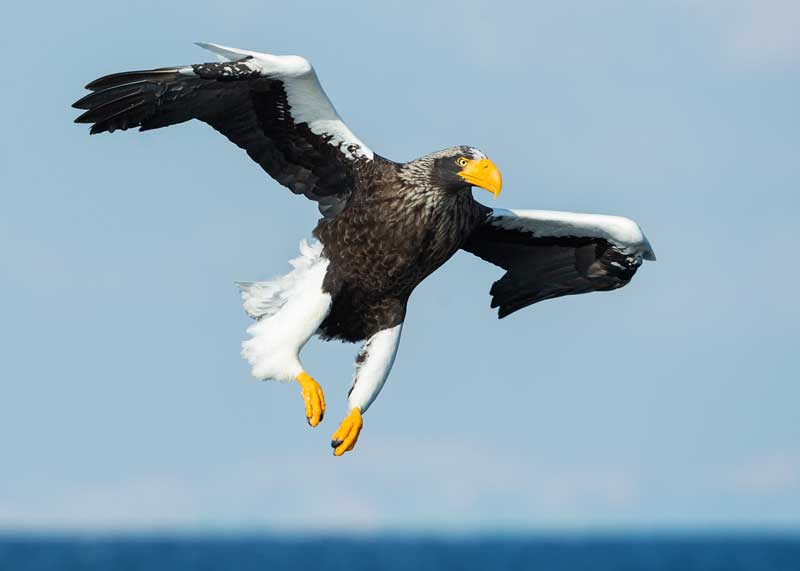
This list is based on median averages. Therefore, outliers
among the species are not included.
After the list, there will be a
longer description of each of
these impressive birds.
Largest
Eagles
by Weight
| Rank | Common Name | Scientific Name | Location | Weight |
| 1 | Steller’s Sea-Eagle | Haliaeetus pelagicus | Asia | 14.75 pounds (6.7 kilograms) |
| 2 | Philippine Eagle | Pithecophaga jefferyi | Asia (the Philippines) | 14 pounds (6.35 kilograms) |
| 3 | Harpy Eagle | Harpia harpyja | Central and South America | 13 pounds (5.95 kilograms) |
| 4 | White-Tailed Sea-Eagle | Haliaeetus albicilla | Europe, and Asia | 10.5 pounds (4.8 kilograms) |
| 5 | Martial Eagle | Polemaetus bellicosus | Africa | 10.25 pounds (4.6 kilograms) |
Largest
Eagles
by Length
| Rank | Common Name | Scientific Name | Location | Total Length |
| 1 | Philippine Eagle | Pithecophaga jefferyi | Asia (the Philippines) | 39.4 inches (100 centimeters) |
| 2 | Harpy Eagle | Harpia harpyja | Central and South America | 38.8 inches (98.5 centimeters) |
| 3 | Wedge-Tailed Eagle | Aquila audax | Oceania (Australia) | 37.6 inches (95.5 centimeters) |
| 4 | Steller’s Sea-Eagle | Haliaeetus pelagicus | Asia | 37.4 inches (95 centimeters) |
| 5 | Crowned Eagle | Stephanoaetus coronatus | Africa | 34.4 inches (87.5 centimeters) |
Largest
Eagles
by Wingspan
| Rank | Common Name | Scientific Name | Location | Wingspan |
| 1 | White-Tailed Sea-Eagle | Haliaeetus albicilla | Europe, and Asia | 86 inches (218.5 centimeters) |
| 2 | Steller’s Sea-Eagle | Haliaeetus pelagicus | Asia | 83.7 inches (212.5 centimeters) |
| 3 | Wedge-Tailed Eagle | Aquila audax | Oceania (Australia) | 82.7 inches (210 centimeters) |
| 4 | Golden Eagle | Aquila chrysaetos | North America, Europe, Asia, and Africa | 81.5 inches (207 centimeters) |
| 5 | Martial Eagle | Polemaetus bellicosus | Africa | 81.3 inches (206.5 centimeters) |
8 Largest Eagles Now Living
Now that we know the names of
the largest eagles, let’s learn a
little more about each of them.
Here are the 8 largest eagles
now living, listed in
alphabetical order.
1. Crowned Eagle
- Scientific Name: Stephanoae-
- tus coronatus
- Location: Africa
- Habitat: Forest, Savanna, and Wetlands
- Population Status: Near Threatened
- Weight: 5.6-10.4 pounds
- (2.6-4.7 kilograms)
- Length: 2.6-3.2 feet (80-99 centimeters)
- Wingspan: 4.9-5.9 feet (150-
- 180 centimeters)
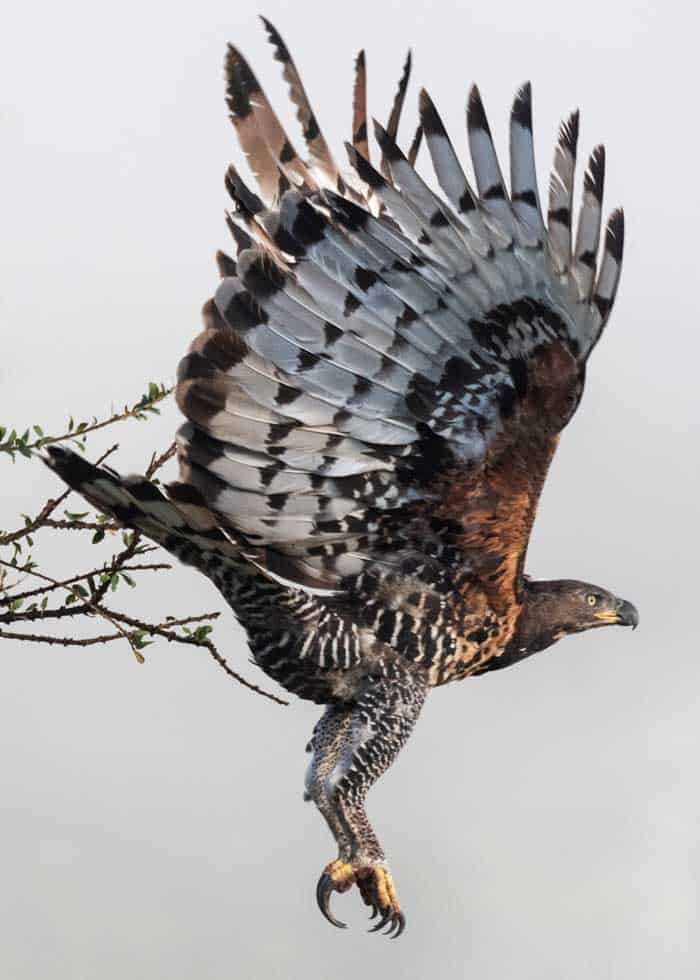
The crowned eagle, or African crowned eagle, lives in the dense forests of sub-Saharan Africa.
They feed on antelope, rock hyrax, and monkeys, often attacking
prey that is much larger than
themselves.
They have even been known to attack human children. It’s better
to observe these ferocious
raptors from a distance.
Both crowned eagles and golden eagles are some of the fastest
birds in the world.
2. Golden Eagle
- Scientific Name: Aguila chrysaetos
- Location: North America,
- Europe, Asia, and Africa
- Habitat: Forest, Shrubland, Grassland, Rocky Cliffs and Mountains, and Desert
- Population Status: Least Concern
- Weight: 6.6-13.4 pounds
- (3-6.1 kilograms)
- Length: 2.3-2.8 feet (70-84 centimeters)
- Wingspan: 6.1-7.2 feet
- (185-220 centimeters)
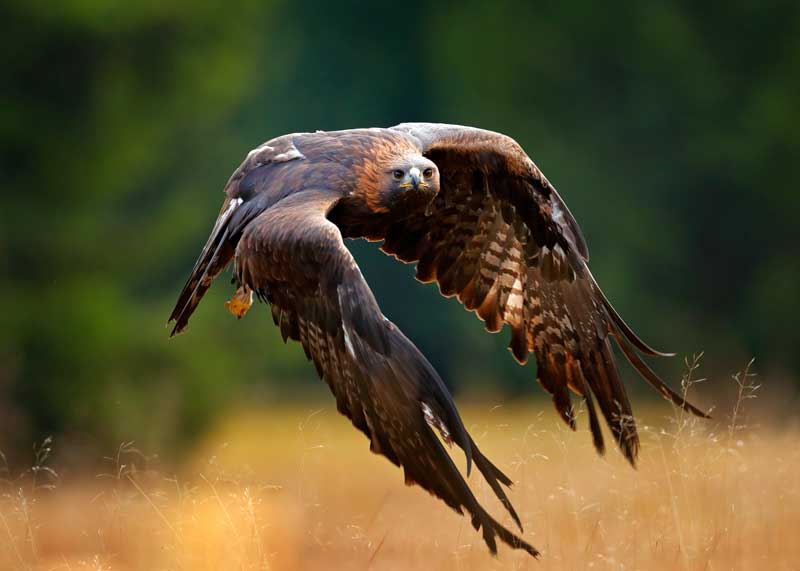
Found throughout the Northern Hemisphere, the Golden Eagle is
the largest bird of prey in North America. Not only are they large,
but they are also quick, reaching speeds of up to 150 miles (241.4 kilometers) per hour.
Unlike the Crowned Eagle, the Golden Eagle tends to favor
smaller prey. Hares, rabbits, squirrels, and groundhogs may all find themselves on the menu.
There are currently 6 recognized subspecies of the Golden Eagle:
- European Golden Eagle (Aquila chrysaetos chrysaetos)
- Iberian Golden Eagle (Aquila chrysaetos homeyeri)
- Asian Golden Eagle/Himalayan Golden Eagle Aquilachrysaetos daphanea)
- Japanese Golden Eagle (Aquila chrysaetos japonica)
- North American Gold Eagle (Aquila chrysaetos canadensis)
- Siberian Golden Eagle / Kamchatkan Golden Eagle (Aquila chrysaetos kamtschatica)
3. Harpy Eagle
- Scientific Name: Harpia
- harpyja
- Location: Central and South America
- Habitat: Forest
- Population Status: Near Threatened
- Weight: 9.7-18.3 pounds
- (4.4-8.3 kilograms)
- Length: 2.8-3.5 feet (86.5-107 centimeters)
- Wingspan: 5.8-7.3 feet (176-
- 224 centimeters)
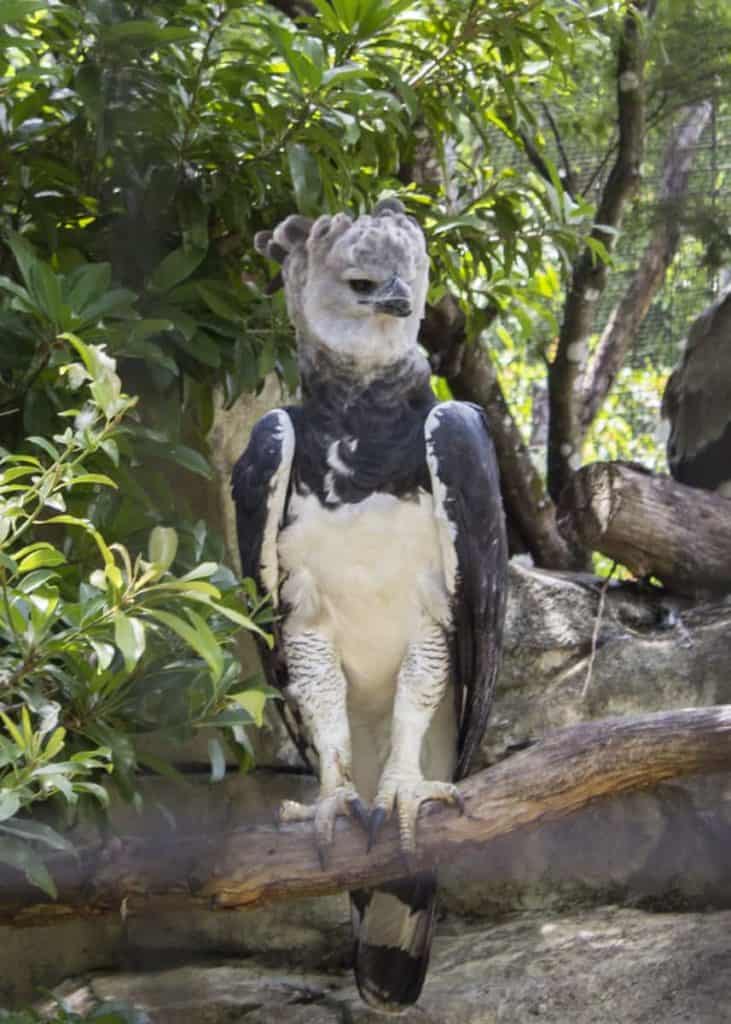
The Harpy Eagle is the third-
largest eagle by weight, and the second-largest by length, in the world. It can be found soaring through the rainforests of Central and South America.
They got their name from the Harpies of Ancient Greek mythology. These creatures were described as having the body of a vulture and the face of a woman and were tasked with delivering
the dead to Hades.
Although those mythical harpies
are not real, these birds are still
pretty terrifying- especially from
the point of view of a monkey
or sloth.
4. Martial Eagle
- Scientific Name: Polemaetus bellicosus
- Location: Africa
- Habitat: Forest, Savanna, Shrubland, Grassland, and Wetlands
- Population Status: Endangered
- Weight: 6.6-13.2 pounds (3-6 kilograms)
- Length: 2.6-3.1 feet (78-96 centimeters)
- Wingspan: 6.2-7.9 feet (188-
- 240 centimeters)
The Martial Eagle is a booted
eagle, meaning that it has
feathers covering its upper legs.
It lives in a wide area in Sub-
Saharan Africa, but its numbers
are on the decline.
Their eyes are nearly as large as
human eyes, which allows them
to see prey up to 3.7 miles (6
kilometers away). They are not
picky eaters- mammals,
reptiles, and other birds are all
on the menu.
In fact, they feast on over 170
different prey. Sometimes this
prey includes poisonous
snakes, jackals, and wild cats.
For birds that are seemingly
shy, they are scary when they
are hungry.
5. Philippine Eagle
- Scientific Name: Pithecophaga jefferyi
- Location: Asia (the Philippines)
- Habitat: Forest
- Population Status: Critically Endangered
- Weight: 8.9-17.6 pounds (4-8 kilograms)
- Length: 2.8-3.4 feet (86-102 centimeters)
- Wingspan: 6-7.2 feet (184-220 centimeters)
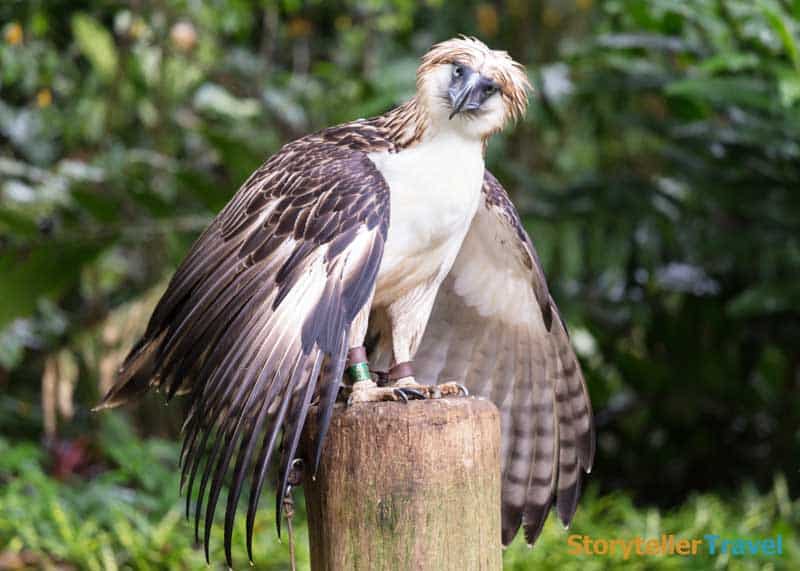
The Philippine Eagle is the long-
est eagle in the world (from the
top of its head to the tip of its
tail feathers), and the second-
heaviest. And even though it
doesn’t have the longest
wingspan, it does have the
largest wing surface.
These majestic birds are now endangered due to deforestation. As a result, anyone caught killing
a Philippine Eagle may face up
to 12 years in prison.
6. Steller’s Sea Eagle
- Scientific Name: Haliaeetus pelagicus
- Location: Asia
- Habitat: Wetlands, Rocky Cliffs and Mountains, Coastal, and Marine Areas
- Population Status: Vulnerable
- Weight: 10.8-20.9 pounds (4.9-9.5 kilograms)
- Length: 2.8-3.4 feet (85-105 centimeters)
- Wingspan: 6.4-8.2 feet (195-
- 250 centimeters)
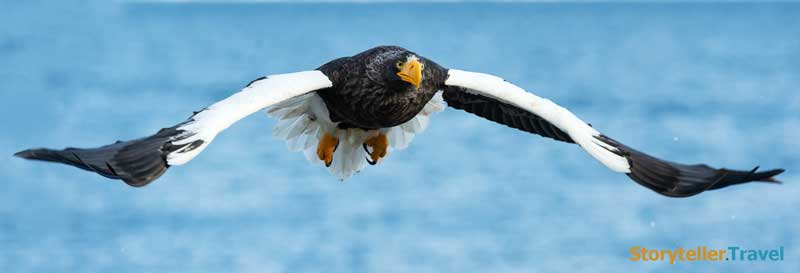
The Steller’s Sea Eagle is the heaviest eagle in the world. They live in coastal areas in North-
eastern Asia, mostly in Russia and Japan.
Because of their proximity to the sea, fish and water birds (like
ducks, geese, and gulls) make up the majority of their diet. They love salmon and trout.
7. Wedge-
Tailed Eagle
- Scientific Name: Aquila audax
- Location: Oceania (Australia)
- Habitat: Forest, Savanna, Shrubland, and Grassland
- Population Status: Least Concern
- Weight: 4.4-12.8 pounds
- (2-5.8 kilograms)
- Length: 2.7-3.5 feet (81-106 centimeters)
- Wingspan: 6-7.6 feet (182-232 centimeters)
Affectionately known as “Wedgies”
in Australia, these large birds of
prey can soar for hours on end
without a single wingbeat (taking advantage of thermal updrafts).
They are also smart, especially when it comes to hunting techniques. When hunting larger prey like kangaroos, they will team up and hunt together. They also know how to herd goats off of
cliffs, and to isolate weaker animals in a flock.
Wedgies are the only bird that has a reputation for attacking
paragliders, tearing apart the fabric with their sharp talons. In Latin Audax means bold, I can see why.
8. White-Tailed Sea-Eagle
- Scientific Name: Haliaeetus albicilla
- Location: Europe, and Asia
- Habitat: Forest, Grassland, Wetlands, Marine, and Coastal Areas
- Population Status: Least Concern
- Weight: 6.8-15.2 pounds (3.1-
- 6.9 kilograms)
- Length: 2.2-3.1 feet (66-94 centimeters)
- Wingspan: 5.8-8 feet (178-245 centimeters)
To picture how big the White-
Tailed Sea Eagle is, you may want to pull out your measuring tape. Can you imagine an eagle with an 8-foot (245 centimeters) wingspan?
That’s more than 2 feet longer than my height!
You may have noticed that some
of the forest-dwelling eagles have
slightly shorter wings, and the
sea-dwelling eagles have longer
wings.
This is because the sea eagles do
not have to maneuver around
trees while hunting. They do,
however, like to perch on tree
branches, using a sit-and-wait
method to spot fish in shallow
water.
Learn more about the world’s largest birds that fly.
The Largest Eagle Ever! (Now Extinct)
Some of the eagles on our list are vulnerable, threatened, or endangered.
Let’s hope that they do not get to the point of extinction, like the
eagle below.
9. Haast’s Eagle
- Scientific Name: Hieraaetus moorei
- Location: Oceania (New Zealand)
- Habitat: Forest and Scrubland
- Population Status: Extinct
- Average Weight: 22 pounds
- (10 kilograms)
- Average Length: 4.3 feet (130 centimeters)
- Average Wingspan: 8.5 feet
- (260 centimeters)
The huge Haast’s Eagle would
have been a sight to behold. Its shorter wings allowed it to glide through its forested home in New Zealand, hunting prey with ease.
Haast’s eagle is likely the pouakai (poukai) of Maori legend that was said to kill and eat humans.
Its favorite food was likely Moa- a flightless bird nearly 15 times the weight of the Haast’s Eagle.
Unfortunately, this large eagle has been extinct since around the
year 1400. It is said that the first
humans to settle in New Zealand
arrived in 1280. The humans
hunted the Moa to extinction,
leaving the Haast’s Eagle with
nothing left to eat.
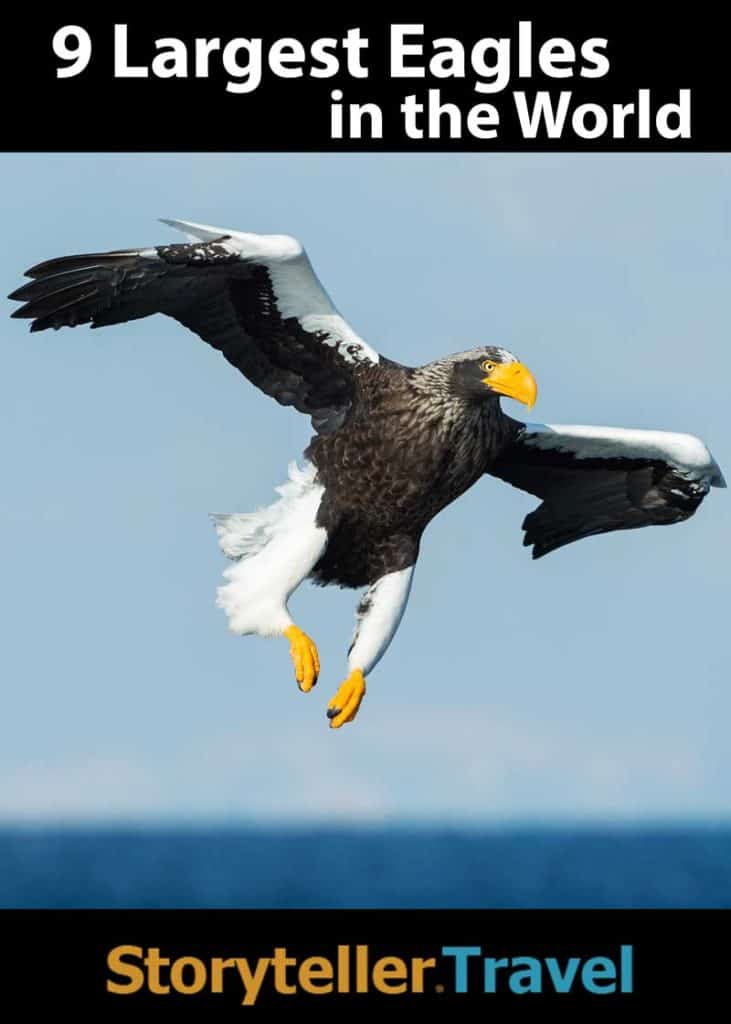

No comments:
Post a Comment